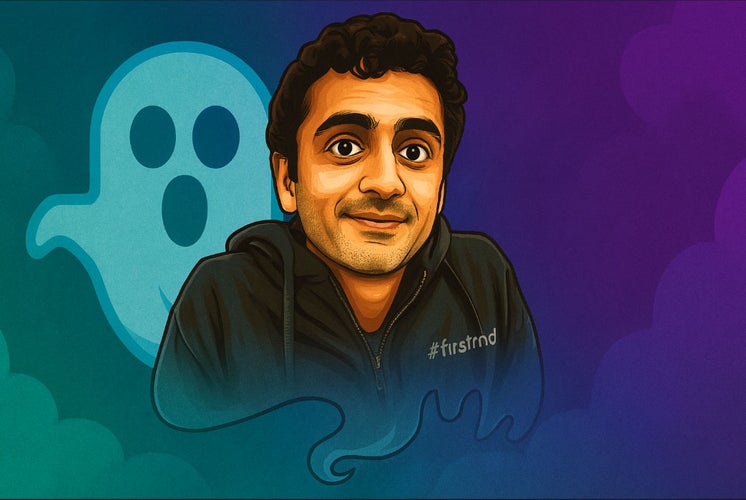Contents
- The Ghost in The Machine
- The Trust Tax and Overemployment
- The Worst Fixes Imaginable
- Rebuilding Trust by Design
- The Antidote to Distrust
- The WorkSmart Scoreboard
- Escaping the Trust Tax for Good
What if the perfect hire on paper was never working for you at all? Shivam Gupta - Senior AI Innovation Specialist at Trilogy - dives into the Soham Parekh scandal to reveal why remote trust is broken, and how to rebuild it by design in the age of the 10X AI engineer.
Silicon Valley thought it had seen every kind of hustle.
The garage visionary, the growth-at-all-costs founder, the pivot-to-crypto opportunist. Then it met a ghost. A ghost who could crush your coding interview, accept your job offer, and be gone by morning - all while working for five other companies.
By now, you’ve heard the name Soham Parekh.
Founders at Playground AI, Lindy, and Fleet AI had all hired him. Some didn’t even know they were sharing their full-time engineer until X lit up with warnings.
Suhail Doshi, co-founder of Mixpanel, recently issued an urgent public service announcement:
“There's a guy named Soham Parekh (in India) who works at 3-4 startups at the same time. He's been preying on YC companies and more. Beware.”
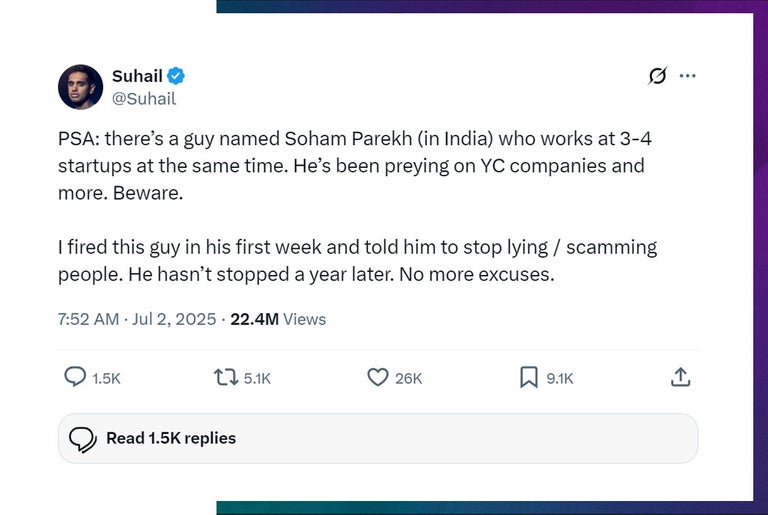
The signs were there – off cameras, vague calendar blocks, and just enough code to get by. But the most disturbing part wasn’t that Parekh hacked the system, it was that he played it exactly as it was designed.
The man had a fake degree from Georgia Tech and delivered solid code.
On paper, he was perfect.
In truth, he exposed the soft underbelly of remote work - that trust is still mostly built on resumes, gut feel, and a false sense of presence.
Soham wasn’t a bad hire. He was a mirror.
And what we saw scared us.
The Ghost in The Machine
“Microsoft just laid off 9,000 workers. All of them Soham Parekh,” one user joked on X.
How did some of the smartest founders in Silicon Valley get fooled by this guy? Parekh weaponized the nature of remote work to maintain his lucrative charade.
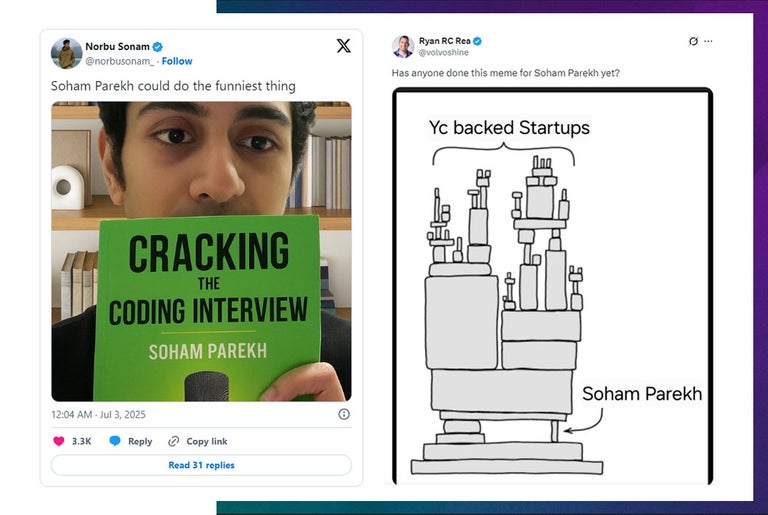
The Soham Parekh scandal went viral not because of the money or the lies - but because he exposed every remote leader’s worst fear - that trust is being quietly and constantly abused by global hires.
Parekh shattered the old hiring playbook.
In remote startups where trust holds everything together, he proved resumes, interviews, and degrees mean nothing without real accountability.
He was the ghost in a system never built for remote work.
The Trust Tax and Overemployment
It’s tempting to dismiss Soham Parekh as a uniquely brazen outlier.
But he’s part of a broader movement of overemployed tech workers. On the sub-Reddit, r/overemployed, half a million people now share strategies to juggle multiple remote jobs - mouse jigglers, outsourced tasks and AI-enhanced lies.
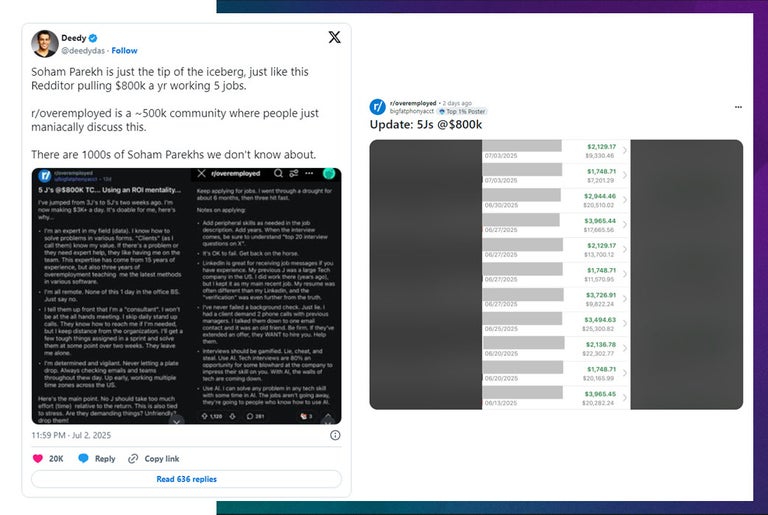
They have a playbook, and it's a direct assault on the foundational ethics of traditional employment. Without in-person checks and balances, the system falls apart.
The real cost to companies is a trust tax:
- Wasted pay on fake contributors
- Lost productivity from split focus
- Burnout and morale decay among honest teams
- Missed opportunities to hire global talent due to fear
Most companies still trust the wrong things - butts in seats, resumes, Zoom smiles. Remote work didn’t break that model, it just exposed that it was broken all along.
The trust tax is the cumulative price of operating with a broken trust model that can’t function without constant physical presence.
The Worst Fixes Imaginable
Trust isn't a soft skill - it's a hard metric.
A 2024 Great Place to Work Trust Index survey analyzing 1.3 million employees found that cooperation (a direct product of trust) is the cornerstone of discretionary effort and productivity.
Employees in high-trust companies are more engaged, more productive, and less likely to burn out. Research also shows that a lack of trust in management is a potent factor in employee stress, leading to disengagement and turnover.
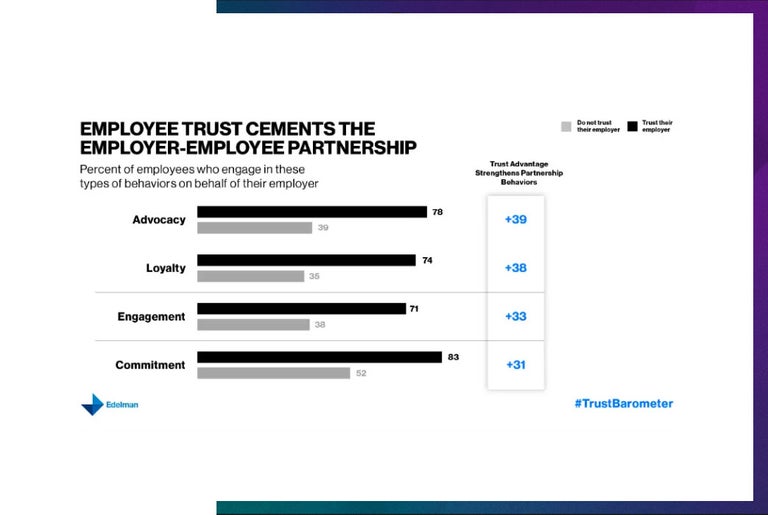
The idea that you can command productivity through control is a fallacy, you can only earn it through trust. The overemployed see ‘time in seats’ not ‘value created’ as the path to success.
If a brilliant engineer can deliver their expected 40 hours of value in 10 hours of focused effort, the system has a 30-hour inefficiency.
The traditional 40-hour work week is a relic of the industrial age, a poor measure for the non-linear, burst-driven nature of knowledge work.
Soham Parekh is a 10X engineer AND a scammer.
Hiring people based on plausibility instead of verifiable performance is how we create both a genius and a fraud in the system. It’s a catastrophic failure of measurement.
Instead of evolving, companies panicked.
That’s when return-to-office mandates and bossware surveillance took over.
The result was productivity theater. Employees optimizing for visibility, not output.
It’s about performing the act of work and management in a way that is visible and reassuring to the old guard. It’s a culture of performative busyness that actively destroys the deep, uninterrupted focus required for genuine knowledge work.
Companies that couldn’t force full RTO defaulted to bossware. This is the technological manifestation of the trust tax - a costly, invasive, and ultimately counterproductive attempt to digitally replicate the watchful eye of the office manager.
Surveillance doesn’t build trust - it breaks it. It rewards appearances and punishes deep work. And it signals management has no idea what excellence actually looks like.
This top-down, fear-based approach is fundamentally at odds with everything we know about what drives high performance.
Rebuilding Trust by Design
If the old model of trust-by-proximity is broken, and the new model of trust-by-surveillance is a toxic failure, what comes next?
We’re stuck debating where people work, which is the wrong conversation.
It reminds me of what Peter Drucker taught: what gets measured gets improved. The only question that matters is, how do we make great work visible and reward it fairly?
True talent doesn't need to be managed, it needs to be seen.
We can't simply wish for a better culture, we have to build one. We have to engineer a system where trust is the guaranteed output, not a hopeful input.
This requires a radical redesign of how we find, measure, and reward talent. It means shifting from a foundation of subjective faith to one of objective verification.
The table below outlines this fundamental shift. It contrasts the flawed legacy model that Soham Parekh exploited with an engineered model designed to prevent it.
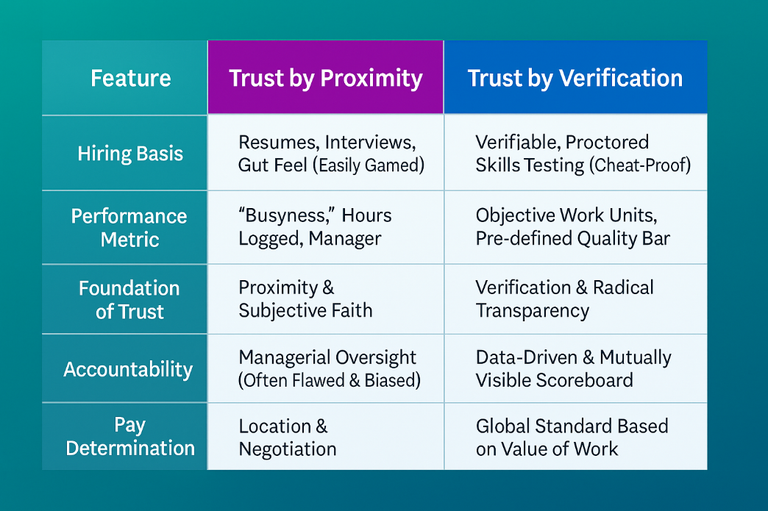
This isn't a theoretical blueprint.
It’s the operational reality at Crossover, a system built from the ground up to solve the core challenges of global, high-performance remote work. It’s not perfect, but one thing is clear – for true high performers who believe in transparency, it works.
The Antidote to Distrust
The first step in engineering trust is to build an impenetrable filter at the front door.
Crossover's hiring process is precisely that - a trust filter designed to answer one simple question: "Can you actually do the job at an elite level?"
It begins by throwing out the tools that Parekh so masterfully exploited.
There are no resumes to fake, no charming interviews to ace. These traditional elements are recognized as sources of bias and deception. Instead, the process is an objective, multi-stage gauntlet of tests.
It starts with the Criteria Cognitive Aptitude Test (CCAT), a standardized, time-pressured exam that measures raw problem-solving ability, critical thinking, and the capacity to learn - key predictors of success in complex roles.
Candidates who meet the high cognitive bar then move to subject matter expert tests and real-world job assignments.
A software engineer will be asked to complete a challenging coding task, a marketing manager will have to produce excellent copy. These assignments are graded blindly by other experts to eliminate bias.
The final, critical step is the one that makes the system cheat-proof.
Any candidate who passes the entire process and receives a job offer must then take a proctored version of the CCAT under strict, video-monitored exam conditions.
This ensures that the person who passed the tests is the person you are hiring. It’s the direct antidote to the ‘ghost’ problem.
The WorkSmart Scoreboard
Now for the most controversial piece of the puzzle.
The idea of a tool tracking your work sounds like a dystopian nightmare. In a low-trust, low-pay environment where management is looking for excuses to punish people, it is a nightmare. But under the right circumstances, radical transparency protects both sides.
Yes, we track work. But not to spy.
We give our top engineers the best tools to write code - why wouldn't we give them the best tools to measure their own focus? WorkSmart makes the professional contract simple and honest. My work speaks for itself through data, not politics.
It’s the most straightforward professional relationship I’ve ever had.
WorkSmart logs output and activity to build a scoreboard, not a surveillance feed. Every role has a defined unit of work and a quality bar. That’s what we measure.
This protects high performers from politics, harassment and bias. It makes the contract clear: elite pay for elite output.
WorkSmart is the tool that provides objective, verifiable data on whether the agreed-upon work was delivered to the agreed-upon standard.
It captures screenshots, webcam photos, and application usage to create a transparent record of the work being done.
This model fundamentally rewrites the employment contract. It moves from a vague agreement based on time ("I pay you X to work for 40 hours") to a precise agreement based on output ("I pay you Y to produce Z work units at quality level A").
This is the key that unlocks a truly global, asynchronous workforce.
The criticism that this system is dehumanizing often comes from people applying a traditional work mindset to a radically different system.
For the top 1% who want to be judged solely on the quality of their work, this isn't dehumanizing - it's the ultimate form of professional respect.
And in its purest form, it’s freedom.
Escaping the Trust Tax for Good
The Soham Parekh story isn’t a cautionary tale about a single renegade scammer. It’s a stress test the old system flat-out failed.
Patchwork fixes like forcing people back to the office and installing paranoid surveillance software - are not real solutions.
They’re symptoms of the same disease - a profound lack of a functional trust mechanism for the digital age. They only deepen the crisis and increase the trust tax that companies pay every day in lost productivity and decaying morale.
If we keep relying on charm, credentials, and vibes to build remote teams, we’ll keep paying this trust tax.
A truly systemic solution is one that makes deception impossible by design.
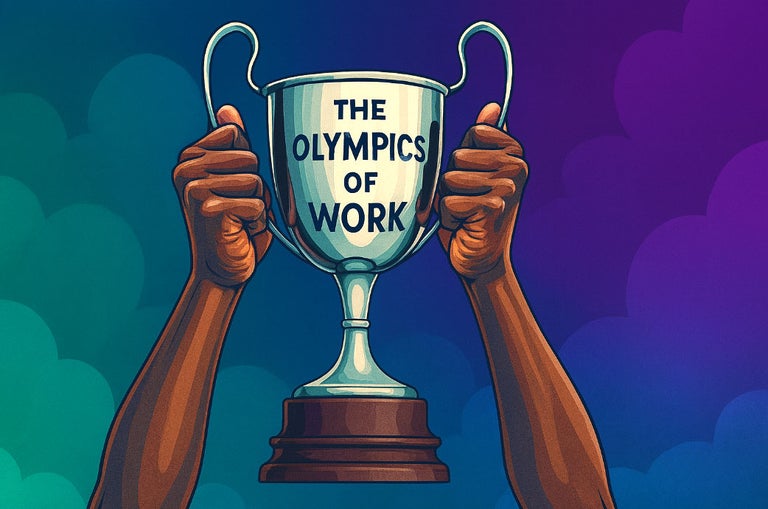
In a system of trust by verification, a Soham Parekh can’t exist.
He would be filtered out at the first gate. He couldn’t fake his way through a proctored cognitive exam or a real-world coding challenge designed by world-class experts.
At the same time overemployed workers can’t survive in an environment of radical transparency. The WorkSmart scoreboard, tied directly to clear output metrics and quality bars, would immediately expose divided focus.
So true freedom isn't the freedom to slack off undetected.
That's a cynical, low-ambition version of the future. True freedom is the freedom from the tyranny of the office, freedom from the bias of a manager's gut feel, freedom from having your pay dictated by your zip code.
It’s the freedom to be judged solely on your merit and to be compensated based on the value you create, not your proximity to power.
The future belongs to teams who build trust into the system. Where cheating is impossible and talent wins on merit. Where output, not optics, earns the reward.
That’s not just a better system. It’s the only one that scales.
That’s the Olympics of work.


